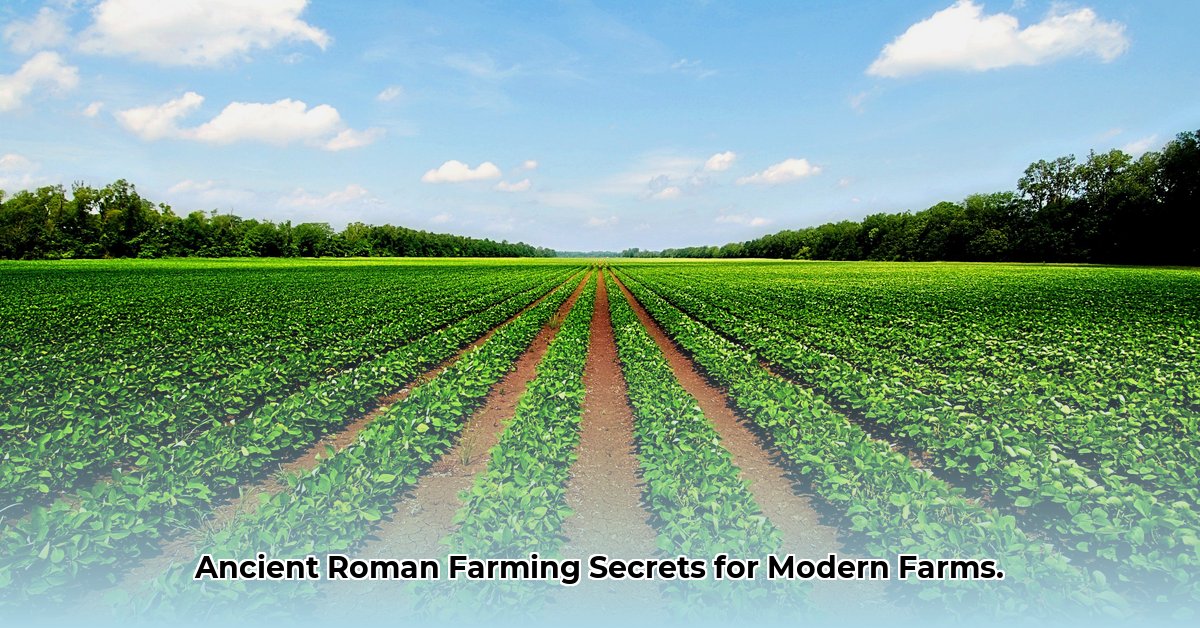Imagine a world without industrial farms, synthetic chemicals, or genetically modified crops. For over a millennium, the ancient Romans cultivated a vast empire, feeding millions without modern technology. Their agricultural ingenuity wasn’t just a matter of survival; it was deeply intertwined with their culture, economy, and very identity. Unearthing their farming practices reveals not just historical facts, but enduring secrets for building truly sustainable agriculture in our modern world. You can learn more about this: ancient Roman agriculture.
From innovative water management to profound insights into soil health and crop diversity, Roman farmers laid foundational principles that remain profoundly relevant. Yet, their journey also offers a cautionary tale: the pursuit of scale and profit, coupled with social imbalances, ultimately sowed the seeds of decline. By understanding both their triumphs and their missteps, we can cultivate a future where our farms flourish in harmony with the planet, mimicking nature’s wisdom while avoiding past pitfalls. Let’s delve into the heart of ancient Roman agriculture and discover how their timeless techniques can inspire a greener, more resilient tomorrow.
The Foundation of an Empire: Pillars of Roman Agricultural Success
For centuries, Roman farmers were masters of their craft, turning diverse landscapes into productive food systems. Their success was built on several key pillars that prioritized long-term productivity and resource management.
Crop Rotation: Nature’s Intricate Dance for Soil Health
The Romans instinctively grasped a fundamental truth: continuous planting of the same crop depletes soil. Their solution was crop rotation, an elegant system that naturally replenished nutrients and managed pests. This wasn’t merely a trick; it was a sophisticated understanding of ecological balance.
A common rotational cycle might look like this:
- Legumes (e.g., beans, lentils, lupines): These “nitrogen fixers” were planted first. As Columella noted in De re rustica, lupines, in particular, were lauded for requiring “the least labor, costs least, and of all crops that are sown is most beneficial to the land,” serving as an “excellent fertilizer for worn out vineyards and ploughlands.” They draw atmospheric nitrogen and convert it into a form plants can use, enriching the soil for subsequent crops.
- Grains (e.g., wheat, barley, spelt): Following legumes, nitrogen-hungry cereals like durum wheat—the preferred grain for leavened bread in urban centers—or barley would thrive on the replenished soil. Varro indicates a healthy 10:1 seed-yield ratio for wheat on wealthy estates, testament to effective soil management.
- Fallow Periods: Often, a field would lie fallow (unplanted) for a season. This “rest” allowed the soil to recover, accumulate moisture, and break pest cycles. Sometimes, cover crops were planted during fallow periods and then tilled back into the earth, further enhancing soil fertility and suppressing weeds.
This systematic rotation boosted crop yields without external inputs, fostering farm resilience that modern monoculture systems often lack.
Organic Fertilization: Harnessing Nature’s Bounty
Before synthetic fertilizers, Roman farmers relied entirely on organic matter to nourish their fields. This included a diverse array of natural “goodies”:
- Animal Manure: Manure from oxen, sheep, goats, and poultry was meticulously collected and applied. Pliny the Elder, in his Naturalis Historia, even detailed the hierarchy of manures: poultry manure was considered best, while cow manure was one of the worst for general use, though horse manure was excellent for meadows. This rich organic matter provided essential nitrogen, phosphorus, and potassium, improving soil structure and water retention.
- Compost: Decomposed plant material, kitchen scraps, and other organic waste were composted, turning “waste” into a valuable soil amendment.
- Green Manure: Specific crops, particularly legumes, were grown not for harvest but to be plowed directly back into the soil, adding biomass and nutrients.
- Ash: Ash from wood or burnt plant material was used to add potassium and other trace elements, enriching the soil profile.
This holistic approach to fertilization prevented nutrient depletion, minimized waste, and supported vibrant soil ecosystems, exemplifying true organic farming principles.
Water Management: Ingenuity in Every Drop
In the Mediterranean’s dry, hot summers, water was a precious commodity. The Romans were unparalleled hydraulic engineers, developing sophisticated water management systems crucial for widespread food production:
- Aqueducts: While famed for supplying cities, Roman aqueducts also branched off to agricultural lands, delivering reliable water for irrigation.
- Irrigation Channels and Ditches: Intricate networks of channels and ditches distributed water precisely where needed, often utilizing gravity alongside tools like the Archimedean screw to lift water to higher ground, as documented by Vitruvius.
- Cisterns: To combat drought, rainwater was collected and stored in vast cisterns and reservoirs for use during dry seasons.
- Terracing: In hilly regions, steep slopes were transformed into productive farmland by cutting horizontal steps or “terraces.” These not only created flat planting areas but also significantly slowed water runoff, preventing erosion and maximizing water absorption, a key strategy for water conservation.
These practices ensured consistent moisture for crops, even in arid conditions, contributing significantly to climate resilience.
Regional Specialization: Optimized Production Across the Empire
The sheer scale of the Roman Empire, stretching across diverse climates, led to a natural regional specialization in agriculture. This allowed for efficient use of diverse landscapes:
| Region | Primary Agricultural Output | Notes |
|---|---|---|
| Egypt & North Africa | Grain (wheat, emmer, spelt) | Became the “breadbasket” of Rome, supplying the capital with immense quantities of grain (estimated 150,000 to 237,000 tonnes annually for its peak population of 1 million). Josephus claimed Africa fed Rome for eight months and Egypt for four, though Sicily also contributed. |
| Italy | Wine, Olive Oil, some Grains (esp. Po Valley) | Initially a significant grain producer, Italy shifted towards high-value crops like grapes and olives due to cheaper grain imports. Volcanic soil in Campania was ideal for viticulture, while the Po Valley excelled in millet and other cereals. Cicero considered farming “the best of all Roman occupations,” and vineyards and olive orchards became highly profitable on large estates. |
| Gaul (France) | Wine, Turnips, Fodder Crops | Developed its own thriving wine industry despite early Roman attempts to protect Italian vineyards. Turnips were a crucial winter fodder crop. |
| Greece | Barley (dominant grain), Olives | Barley dominated grain production, especially on poorer soils, alongside olive cultivation. |
This model maximized output by aligning crops with suitable climates and soils, but it also created complex interdependencies and vulnerabilities in the empire’s food security.
The Seeds of Decline: How Roman Agriculture Faltered
Despite their initial brilliance, Roman agricultural practices eventually faced significant challenges that contributed to the empire’s eventual decline. Understanding these failures is as crucial as appreciating their successes.
The Allure and Pitfalls of the Latifundia System
Early Roman agriculture was built on small, family-owned farms. However, as the Republic expanded, wealthy aristocrats amassed vast estates known as latifundia (over 500 iugera, or approximately 325 acres). These large properties increasingly relied on slave labor, particularly after the Punic Wars drew small peasant farmers away for military service.
The shift had profound consequences:
- Social Dislocation: Small farmers, unable to compete or maintain their land, were often forced to sell out to the wealthy, migrating to overcrowded cities. This “mass eviction of the poor by the rich” fueled social tensions and civil strife.
- Reduced Innovation & Care: Slave labor, while cheap, often lacked the incentive for innovation or meticulous care that independent farmers invested. As William Stearns Davis noted, masters often treated slaves “according to cold regulations, like so many expensive cattle,” leading to brutal conditions and minimal investment in long-term soil health.
- Monoculture Tendencies: Larger estates often favored single, profitable crops for export, leading to less diversified crop rotations and increased vulnerability to pests and diseases.
Environmental Degradation: The Land Bears the Brunt
The relentless demand for agricultural output, coupled with a lack of understanding of long-term ecological impacts, led to extensive environmental degradation:
- Soil Exhaustion: While crop rotation was practiced, intensive cultivation and insufficient nutrient replenishment on vast estates led to widespread soil exhaustion. The volcanic ash of the Latium plain, though initially rich, had a thin surface soil “easily exhausted.”
- Deforestation: Great forests were cleared for timber, fuel, and new agricultural land. This widespread deforestation on hillsides led to severe soil erosion, increased runoff, and altered local microclimates, making land less productive and exacerbating drought conditions.
- Lack of Investment: As the empire faced internal strife and external threats, investment in agricultural infrastructure and conservation measures waned, further weakening the system.
Over-reliance on Imports: A Fragile Food Security Model
As Rome’s urban population swelled to an estimated one million at its peak, feeding the capital became an enormous logistical challenge. Rome grew heavily dependent on imported grain from its provinces, especially Egypt and North Africa, a system known as the Cura Annonae (grain dole).
This reliance, while providing cheap food, created significant vulnerabilities:
- Supply Chain Disruptions: Wars, piracy, political instability, or natural disasters (like the Egyptian crisis of 99 AD due to inadequate flooding, as noted by Pliny the Younger) could severely disrupt grain shipments, leading to food shortages and unrest in Rome.
- Loss of Self-Sufficiency: Italy’s own grain production declined as it was cheaper to import. This made the core region of the empire less resilient to external shocks.
- Economic Vulnerability: The immense cost of the grain dole, especially after it became free in 58 BC, was a significant burden on the imperial treasury, eventually paid directly by emperors from their personal holdings in Egypt.
Ancient Wisdom, Modern Solutions: Reimagining Roman Techniques for the 21st Century
The story of Roman agriculture is a powerful lesson in the delicate balance between productivity and sustainability. By learning from both their remarkable achievements and their eventual missteps, modern farmers and policymakers can forge more resilient and equitable food systems.
Practical Implementation: Step-by-Step Guide to Roman-Inspired Farming
How can a modern farm, big or small, integrate these ancient principles?
- Conduct Comprehensive Soil Analysis: Just as Roman farmers observed their land, begin with a thorough soil test. Understand its nutrient profile, pH, and organic matter content. This baseline informs all subsequent decisions.
- Strategic Crop Rotation Planning:
- Identify Crop Families: Group your current crops by family (e.g., legumes, cereals, brassicas, root vegetables).
- Design a Multi-Year Cycle: Create a 3-5 year rotation plan. A simple cycle might be: heavy feeder (corn, wheat) -> nitrogen fixer (soybeans, clover) -> root crop (potatoes, carrots) -> fallow/cover crop.
- Vary Root Depths: Rotate deep-rooted crops with shallow-rooted ones to utilize nutrients at different soil levels.
- Incorporate Cover Crops (Green Manure): Plant non-cash crops like rye, vetch, or clover during off-seasons. Till them into the soil before planting cash crops to add organic matter and nitrogen.
- Implement Holistic Organic Fertilization:
- Compost Management: Establish a robust composting system for farm waste, animal manure (if applicable), and even kitchen scraps. Ensure proper decomposition to maximize nutrient availability.
- Manure Application: If using animal manure, compost it thoroughly before application to kill pathogens and seeds. Apply based on soil test recommendations to avoid nutrient overload.
- Biochar and Ash: Explore integrating biochar (charcoal from biomass) to improve soil structure and nutrient retention, and use wood ash judiciously for potassium.
- Optimize Water Management:
- Rainwater Harvesting: Install systems to collect rainwater from barns, greenhouses, and other structures into cisterns or ponds for irrigation.
- Precision Irrigation: Adopt modern equivalents of Roman efficiency, such as drip irrigation or micro-sprinklers, to deliver water directly to plant roots, minimizing waste.
- Contour Farming/Terracing: On sloped land, adopt contour plowing or build terraces (if feasible) to slow water runoff, prevent erosion, and enhance water infiltration.
- Mulching: Use organic mulches (straw, wood chips) to conserve soil moisture, regulate temperature, and suppress weeds.
- Re-evaluate Regional and Local Focus:
- Grow What Thrives Locally: Prioritize crops best suited to your specific climate and soil, reducing the need for intensive inputs.
- Support Local Food Systems: Engage with local markets, CSAs (Community Supported Agriculture), and farm-to-table initiatives to reduce transportation costs and environmental impact, fostering food security within your community.
- Diversify Production: While not purely Roman specialization, diversify your farm’s output to include a variety of crops, and perhaps even livestock, to build resilience against market fluctuations or single-crop failures.
Enduring Lessons and Future Cultivation
The Roman agricultural narrative is a powerful reminder that “progress” isn’t always linear. Their innovations, resourcefulness, and deep connection to the land (at least in early periods) offer invaluable insights for contemporary agriculture. Conversely, their decline serves as a stark warning about the perils of unchecked expansion, social inequity, and environmental neglect.
By intentionally adopting practices like diversified crop rotation, enriching soils with organic matter, meticulously managing water resources, and re-emphasizing local strengths, we can steer modern farming toward a more sustainable and resilient future. Agriculture ancient Rome provides a blueprint, not for replication, but for thoughtful adaptation. It’s a call to cultivate not just crops, but also wisdom, ensuring that our food systems nourish both humanity and the Earth for generations to come.
| Ancient Roman Practice | Modern Application (Inspired by Roman Wisdom) | Benefits for Contemporary Agriculture |
|---|---|---|
| Comprehensive Crop Rotation | Multi-year rotation schedules using diverse plant families (legumes, cereals, root crops, leafy greens), including cover crops (green manure) during fallow periods or between cash crops to enhance biodiversity, suppress weeds, and manage pests naturally. | Soil Health & Productivity: Improves soil structure, increases organic matter, sequesters carbon, and naturally replenishes specific nutrients (e.g., nitrogen from legumes), reducing the need for synthetic fertilizers. Pest & Disease Control: Disrupts pest and disease cycles by removing host plants, leading to healthier crops and reduced reliance on pesticides. Farm Resilience: Enhances the farm’s ability to withstand environmental stressors and market fluctuations through diversified output. |
| Organic Fertilization (Manure, Compost) | Systematic collection and composting of animal manures and agricultural waste (crop residues, food scraps) to create nutrient-rich compost. Application based on soil test results, alongside the use of green manures, biochar, and other natural amendments. | Nutrient Cycling: Provides slow-release, balanced nutrients essential for plant growth, avoiding the nutrient imbalances and runoff associated with synthetic inputs. Soil Structure & Water Retention: Increases soil’s water-holding capacity and aeration, making it more resilient to drought and heavy rainfall. Microbial Life: Supports a thriving soil microbiome, which is crucial for nutrient availability, disease suppression, and overall soil health. Reduced Environmental Impact: Minimizes chemical runoff, water pollution, and greenhouse gas emissions associated with synthetic fertilizer production. |
| Sophisticated Water Management | Implementing rainwater harvesting systems (cisterns, ponds), adopting precision irrigation (drip, micro-sprinklers) to deliver water directly to plant roots, practicing contour farming or terracing on slopes to reduce runoff and erosion, and selecting drought-resistant crop varieties. | Water Conservation: Minimizes water waste, crucial in regions facing water scarcity. Maximizes the efficiency of every drop, leading to greater crop productivity with less water. Erosion Control: Prevents topsoil loss on sloped lands, maintaining essential soil fertility and preventing waterway sedimentation. Climate Resilience: Helps farms adapt to changing rainfall patterns and prolonged dry spells, ensuring stable yields in variable climates. |
| Regional Specialization & Trade | Focusing agricultural efforts on crops that are optimally suited to local climatic, geological, and |










